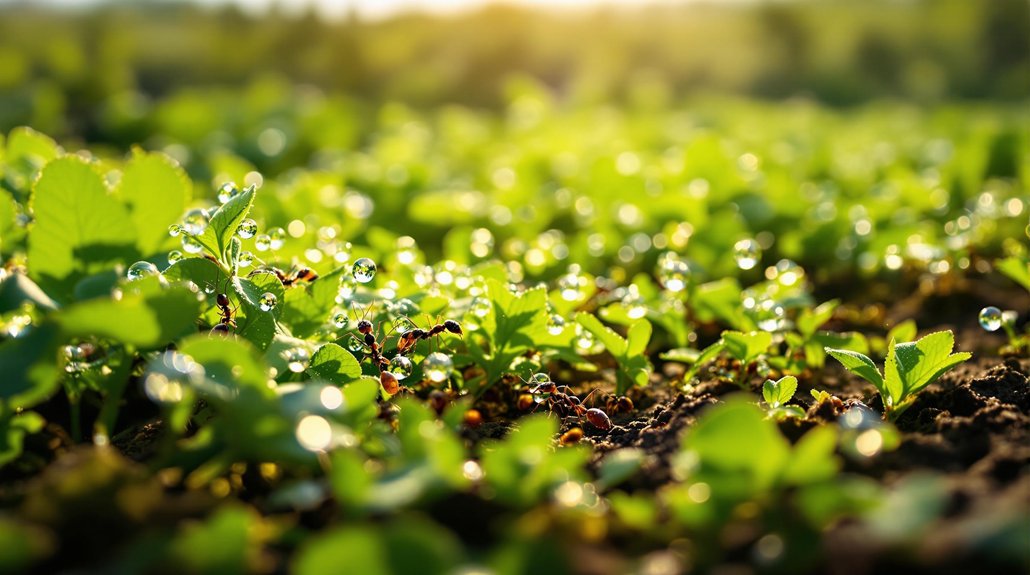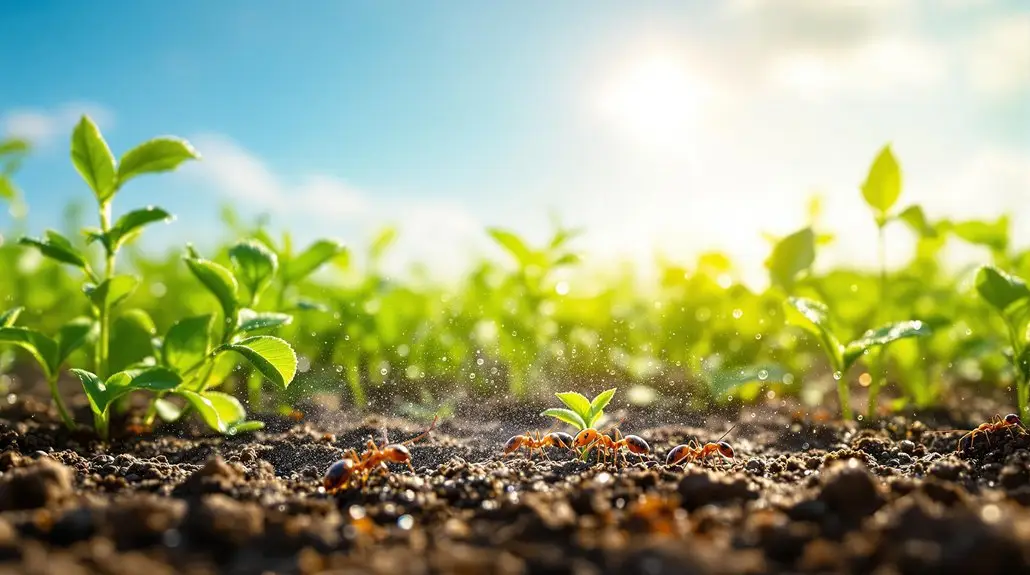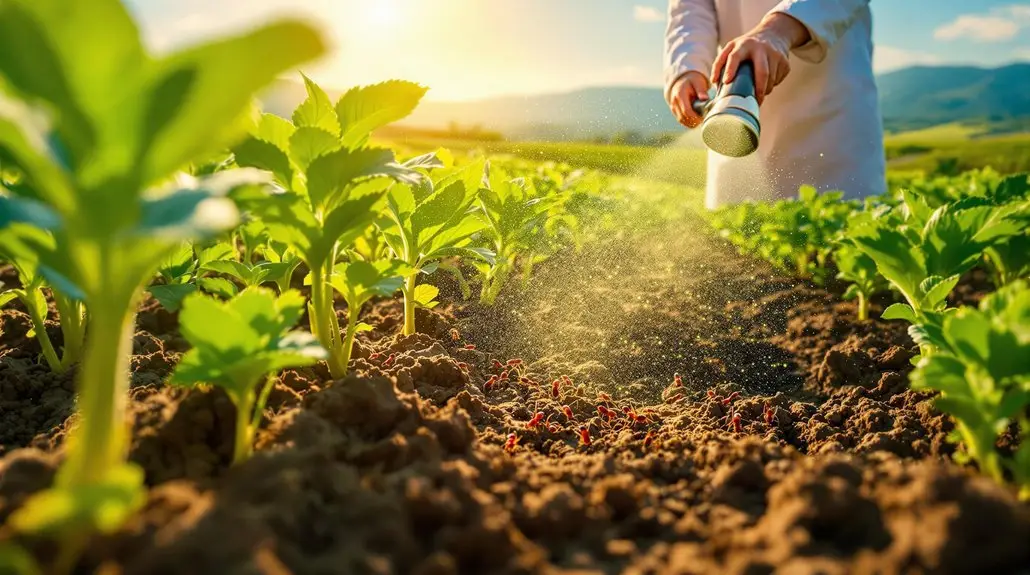Biodegradable chitosan, sourced from crustacean shells, is being used to create innovative green nanopesticides targeting Solenopsis invicta, a harmful invasive fire ant species. These nanopesticides offer enhanced environmental security as they biodegrade, reducing harmful impacts on ecosystems and non-target species. In addition, they improve soil health by minimizing chemical residues and promoting sustainable plant growth through gradual nutrient release. Researchers are actively exploring these advancements, leading to significant progress in sustainable pest management strategies you’ll find intriguing.
Key Insights
- Biodegradable chitosan-based nanopesticides provide an eco-friendly solution for controlling the invasive fire ant species, Solenopsis invicta.
- Chitosan’s antimicrobial properties help reduce fire ant populations while minimizing harm to beneficial insects and the surrounding ecosystem.
- The application of green nanopesticides enhances soil health by promoting microbial balance and reducing chemical residue.
- Chitosan nanopesticides support Integrated Pest Management strategies, optimizing pest control while ensuring sustainable agricultural practices.
- Utilizing chitosan in agriculture aligns with future trends towards eco-friendly pest control and improved ecosystem health.
Understanding Chitosan and Its Properties

Chitosan, a biopolymer derived from chitin, exhibits unique properties that make it an essential subject of research in agriculture. This natural polymer, obtained from crustacean shells, possesses excellent biodegradability and non-toxicity, making it a sustainable alternative to synthetic agricultural chemicals.
When you investigate its characteristics, you’ll find that chitosan has remarkable film-forming abilities, which allow it to create protective barriers on plant surfaces, enhancing their resistance to pests and diseases. In addition, its antimicrobial properties help control harmful microorganisms, promoting healthier crop growth.
Researchers have discovered that chitosan can also enhance nutrient absorption, ensuring that plants receive essential elements more efficiently. Furthermore, its ability to stimulate plant growth and development makes it a valuable tool for sustainable agriculture.
As you explore deeper into the world of chitosan, you’ll appreciate its potential to contribute to environmentally friendly farming practices that benefit both crops and the ecosystem.
The Challenge of Solenopsis Invicta in Agriculture
As farmers endeavor to maintain healthy crops, they often find themselves combating the invasive fire ant, Solenopsis invicta, which poses significant challenges to agricultural practices.
This species, known for its aggressive nature and rapid reproduction, disrupts ecosystems and damages crops through their foraging behavior. They create extensive mounds, which can damage farm equipment and hinder field operations.
In addition, their presence can lead to reduced yields, as they often consume seeds and seedlings, impacting plant growth. Farmers may also face increased costs related to pest management strategies, which can strain budgets and resources.
Additionally, the fire ants’ ability to adapt to various environments complicates control measures. As you work to manage these pests, understanding their behavior and the potential ecological impact becomes vital. Implementing eco-friendly methods for ant control can further support sustainable agricultural practices and protect crops from infestations.
This knowledge not only aids in developing effective strategies but also fosters a sense of community among farmers facing similar challenges.
Development of Green Nanopesticides From Chitosan

In recent years, researchers have increasingly focused on developing green nanopesticides derived from chitosan, a biopolymer obtained from chitin found in the shells of crustaceans.
This innovative approach addresses the pressing need for environmentally friendly pest control solutions, particularly against challenging pests like Solenopsis invicta. By utilizing chitosan, scientists are harnessing its natural properties to create effective nanopesticides that are biodegradable and less harmful to the ecosystem.
Key benefits of these green nanopesticides include:
- Reduced chemical toxicity, making them more secure for non-target species.
- Enhanced biodegradability, ensuring minimal environmental impact.
- Targeted pest control, increasing efficiency in managing infestations.
- Integrated Pest Management strategies can complement the use of these nanopesticides for even greater effectiveness.
As you explore this exciting field, you’ll find that the development of chitosan-based nanopesticides not only offers practical solutions for agriculture but also contributes to a more sustainable future.
Benefits of Biodegradable Nanopesticides for Soil Health
While traditional pesticides often disrupt soil ecosystems, the introduction of biodegradable nanopesticides presents a promising solution that can considerably enhance soil health.
These nanopesticides, derived from natural materials like chitosan, break down over time, reducing their long-term impact on the environment. By minimizing chemical residues, they help maintain a balanced microbial community essential for nutrient cycling and organic matter decomposition, both critical for soil fertility.
Additionally, biodegradable nanopesticides can improve soil structure, promoting better water retention and aeration, which benefits plant roots.
As these products degrade, they release nutrients gradually, supporting sustainable plant growth without the risk of toxicity to beneficial organisms. This method not only fosters a healthier soil ecosystem but also aligns with the growing movement toward sustainable agricultural practices. Furthermore, the use of biodegradable products supports eco-friendly pest control methods that reduce reliance on harmful chemicals.
Future Prospects for Sustainable Pest Management Strategies

Exploring the future prospects for sustainable pest management strategies reveals a landscape increasingly shaped by innovative practices and technologies that prioritize ecological balance.
As you consider these advancements, it’s essential to recognize how they can transform agricultural practices, promoting healthier ecosystems while effectively managing pests.
- Integration of biodegradable materials, like chitosan, enhances soil health and minimizes chemical residues.
- Development of intelligent pest monitoring systems allows for targeted interventions, reducing the need for broad-spectrum pesticides.
- Collaboration between scientists, farmers, and communities fosters a shared commitment to sustainable practices that benefit everyone involved.
- The use of eco-friendly treatments similar to those offered by NaturePest enhances pest control without harming the environment.
Frequently Asked Questions
How Does Chitosan Compare to Traditional Pesticides in Effectiveness?
Chitosan, derived from chitin, demonstrates effectiveness that often rivals traditional pesticides, particularly in its ability to enhance plant growth and boost resistance to pests and diseases.
While traditional pesticides typically target specific pests with chemical compounds, chitosan works by promoting a plant’s natural defenses, reducing the reliance on synthetic chemicals.
Researchers have noted that chitosan’s biodegradable nature presents a more environmentally friendly option, making it a compelling alternative for sustainable agricultural practices.
Are There Any Side Effects of Using Chitosan-Based Nanopesticides?
When considering chitosan-based nanopesticides, you should be aware that while they generally exhibit lower toxicity compared to traditional pesticides, they can still have side effects.
Some studies indicate potential impacts on non-target organisms, such as beneficial insects or soil microorganisms. Additionally, certain formulations may cause mild allergic reactions or irritation upon contact.
Therefore, understanding these effects is essential for responsible use in agricultural practices, ensuring both efficacy and security in pest management.
What Is the Cost Difference Between Chitosan and Conventional Pest Control Methods?
As the saying goes, “A penny saved is a penny earned.”
When comparing chitosan to conventional pest control methods, you’ll find that chitosan-based solutions often pose lower overall costs.
While initial investments in chitosan may be comparable, their biodegradable nature can reduce long-term expenses associated with harmful chemical residues and environmental remediation.
Additionally, these green alternatives are gaining popularity, potentially leading to lower prices as production scales up, making them an economically viable choice.
Can Chitosan Nanopesticides Be Used on All Types of Crops?
Chitosan nanopesticides can be effective on various types of crops, but their suitability often depends on specific plant characteristics and environmental conditions.
Researchers have found that while chitosan is generally secure and biodegradable, its efficacy may vary based on factors like crop type, growth stage, and pest presence.
It’s crucial to conduct trials to guarantee ideal results, allowing you to maximize the benefits of using these innovative pest control methods in your agricultural practices.
How Long Does It Take for Chitosan Nanopesticides to Degrade in Soil?
Time waits for no one, and neither does chitosan.
Typically, chitosan nanopesticides degrade in soil within a range of 30 to 90 days, depending on environmental conditions such as temperature, moisture, and microbial activity.
Researchers have observed that warmer, moist conditions can accelerate this degradation process, while drier, cooler environments may prolong it.
Understanding this timeframe is essential for effective pest management and sustainable agricultural practices, allowing you to plan your crop cycles accordingly.
Final Thoughts
A New Era in Pest Management
Ultimately, the innovative use of biodegradable chitosan to develop green nanopesticides represents a significant advancement in pest management, particularly against the invasive Solenopsis invicta. By harnessing the natural properties of chitosan, researchers not only address pest control but also promote soil health and sustainability. As these environmentally friendly solutions gain traction, they pave the way for a future where agriculture can thrive without compromising ecological integrity, ultimately benefiting both farmers and the environment alike.
Empowering Agriculture: Join the Green Revolution!
At NaturePest Holistic Pest Control, we are committed to advancing sustainable agriculture practices in South Florida. We invite farmers and agricultural stakeholders to embrace the power of biodegradable chitosan and green nanopesticides. By choosing eco-friendly solutions, you can not only protect your crops but also contribute to a healthier ecosystem. Let’s work together to create a greener future—contact NaturePest today!

